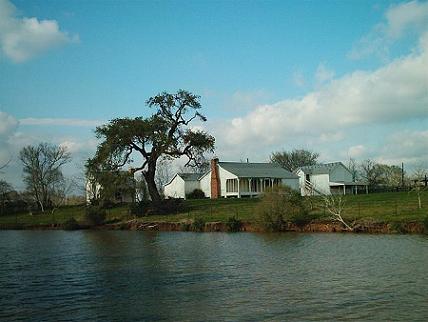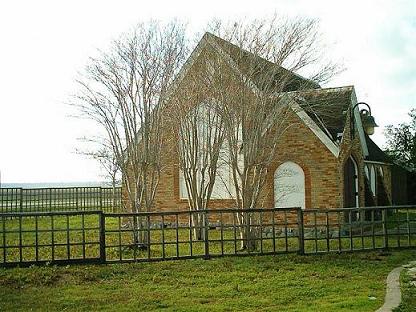To Be Demolished
on Wednesday, November, 21 2012 @ 05:49:00 am (960 words)
In Brazoria County history [ 236697 views ]

The Brock Ranch complex on the eastern edge of Oyster Creek at Stratton Ridge Road (County Road 226) and the brick church that was originally the Bethel Presbyterian Church at the corner of County Road 226 and Farm-to-Market Road 523 are to be demolished just after Thanksgiving 2012 (specifically, the first week of December). It has been stated that the chemical company that leases Brock lands for its salt dome facility has a concern that the ranch buildings are an attraction to vagrants and vandals and so has been wanting the buildings torn down. Efforts to find a new home for the ranch buildings (in the event they could have been saved by moving them) have been unsuccessful. The church cannot be moved, being of brick construction.
An old typescript report titled "Reterio" exists which ends with the words "As told by Mrs. Lois Brock Adriance." Lois Brock Adriance was the daughter of Carrie Stratton Brock, so I thus know that a glaring mistake therein is that of the transcriber of Mrs. Adriance's rendition of the details: viz. "William's [meaning William Joel Bryan's] daughter married a Mr. F. A. Brock, who was the son of an English engineer, who had constructed the jetties at Quintana, at the mouth of the Brazos River, as well as jetties at Sabine Pass and Galveston."
It appears the transcriber skipped a generation. The correct facts are these: William Joel Bryan's daughter Lavinia Perry Bryan married James Thomas Stratton (a son of Asa Evans Stratton, Sr.). James Thomas Stratton and Lavinia (Bryan) Stratton were the parents of "Carrie" (Caroline Austin) Stratton (born November 3, 1875) who on 24 November 1897 married Frederick Augustus Brock III. It was after Lavinia died that the family apparently moved to the Stratton Ridge area. The 1880 census shows James Thomas as Thomas Stratton. The census taker listed Lavinia, but the name was later struck through (she died in 1880 before the official date of the taking of the census). The families around them are the Cox family and the Perrys at Peach Point, so I'd say that Thomas (i.e., J. T. Stratton) was either leasing land or working for his father-in-law, William Joel Bryan. (The census says his occupation in 1880 was "stockraiser"). In 1883, J. T. married Minnie Clemens Dewey (probably related to the Clements family at Ranch Prairie/Phair.) Minnie C. D. Stratton bought from Cora Lewis Bryan (daughter of Ira Randolph Lewis and wife of Moses Austin Bryan) 200 acres in the Reterio vicinity on September 8, 1883. (This may have been the Reterio homeplace.) She had been buying land in that area for a few years. J. T. Stratton is found in deed records buying other property in the area, but it does not appear to be the main part of Reterio.
The Handbook of Texas article "Reterio" says that the plantation dates back to 1847 when it became Moses Austin Bryan's. (He was a nephew of Stephen F. Austin.) He and his family moved to Independence, Texas, in 1862. Who operated the plantation after that is not real clear to me. (Moses Austin Bryan doesn't appear to have started selling it off then.) The Lois Brock Adriance article says that it was eventually put up for tax sale and that William Joel Bryan "purchased land at the sale and kept it within the family." (County deed records show no Moses Austin Bryan lands put up for back taxes sale. In fact, in 1881, Cora Lewis Bryan was buying 821 acres from William Joel Bryan in the S. F. Austin 1/3 league---this is near Phair. So, it doesn't appear that Moses Austin and Cora Bryan were not able to pay their taxes.)
A very interesting point about the ranch buildings, whatever their individual ages, is that one of them, the small one nearest the creek is a slave cabin, if the recollections of Mrs. Lois Brock Adriance are correct! There were other slave cabins but they are all gone now. (Perhaps the remaining one was used as a ranch office.) The Lois B. Adriance article is confusing about the houses, but it appears that Moses Austin Bryan first built a large cabin. This was later replaced (but by whom?) with a large colonial style home. She gives that date as "Following the defeat in the War," but why would a family that has moved to Independence to stay come back to Brazoria County to build a substantial home. (It must have been built before the move to Independence.) Mrs. Adriance says it burned in 1896. Later, she states that Mr. and Mrs. F. A. Brock "rebuilt the ranch house in 1930 and restored the small slave quarters [i.e. cabin]. This wording is problematic. If the colonial burned in 1896, what home existed there between 1896 and 1930? "Rebuilt" might imply that another house existed during that time (1896 to 1930) and that it was refurbished, OR completely demolished and rebuilt. But it could also mean simply that the colonial was the ranch house and after it burned it was not replaced until 1930. But I have two problems with that: 1) Where did the Strattons live between 1896 and 1930? and 2) That looks like an older house than a 1930's ranch house!
Allen Andrew Platter's dissertation Educational, Social, and Economic Characteristics of the Plantation Culture of Brazoria County, Texas (1961) includes a section on Reterio. It contains information from Mrs. F. A. "Carrie" Brock. She stated in 1960 when he interviewed her that the original house was not a log cabin but was a brick building. It states that the house that burned (in 1896 according to Mrs. Lois Brock Adriance) was built after the war. Then there is mention of the (now still) current Brock home, but no mention as to when it was made.
What a shame that so little notice and so little time was given in time to have made it possible to save these structures.

6 comments
This post has 1 feedback awaiting moderation...

